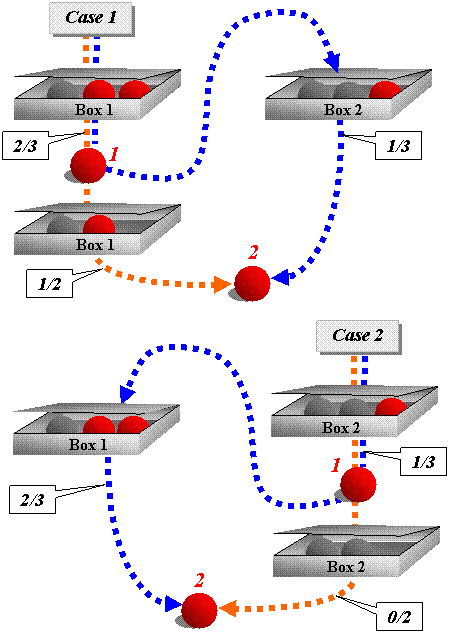 et
us suppose that you have by pure chance removed a red
ball from either
box without seeing inside. In deciding whether to
accept the wager,
you must first decide which box is more likely to give
you a matching red
ball ("success" in the parlance of probability theory). et
us suppose that you have by pure chance removed a red
ball from either
box without seeing inside. In deciding whether to
accept the wager,
you must first decide which box is more likely to give
you a matching red
ball ("success" in the parlance of probability theory).
 On
the
right is a diagram depicting two cases that will help
you make your
decision. Both cases have arbitrarily assumed
that Box 1 contains
two red balls and one black, while Box 2 contains two
black balls and one
red. Case 1 postulates that the red ball was
removed from Box 1,
and Case 2 postulates that the red ball was removed
from Box 2. On
the
right is a diagram depicting two cases that will help
you make your
decision. Both cases have arbitrarily assumed
that Box 1 contains
two red balls and one black, while Box 2 contains two
black balls and one
red. Case 1 postulates that the red ball was
removed from Box 1,
and Case 2 postulates that the red ball was removed
from Box 2.
In both cases, the orange
path indicates that you have decided to take the
second ball from the same
box, and the blue
path indicates that
you have decided to take the second ball from the
opposite box.
Pathway links are marked with their
respective probabilities.
Accordingly, the probability that the first ball would
be red is 2/3
in Case 1 and 1/3 in Case 2. Now,
the first ball is
known
to
be red, so those particular probabilities really
pertain to what is not
known, namely the particular arrangement of the
Balls
in Boxes that is consistent with the
indicated probability.
Same Box
-
In Case 1 the orange
path shows a probability of 1/2 that
the second ball taken
out of the same box
will be red. But
that's not the whole story. You must take into
consideration the
probability that the first ball was red, which is 2/3.
The
joint probability that the second ball will match
the first ball (success)
is given by the product of their individual
probabilities (2/3)(1/2)
= 1/3.
-
In Case 2 the orange
path shows a probability of 0/2 --
impossible -- that
the second ball taken out of the same box
will be red. That would be just about the
whole story, since it does
not matter what the probability is that the first
ball was red (1/3).
The joint probability that the second ball will
match the first ball (success)
is given by the product of their individual
probabilities (1/3)(0/2)
= 0.
Since Case 1 and Case 2 are equally
likely, the overall
probability of success if you make your selection from
the same
box is given by (1/3 + 0) / 2 = 1/6
< 1/2 (less
than an even bet).
Opposite Box
-
In Case 1 you see the joint
probability of success
on the blue
path if you take the second
ball out of the opposite box
will be given
by (2/3)(1/3) = 2/9.
-
In Case 2 you see the joint
probability of success
on the blue
path if you take the second
ball out of the opposite box
will be given
by (1/3) (2/3) = 2/9.
Again, Case 1 and Case 2 are equally
likely, so the
overall probability of success if you make your
selection from the opposite
box is given by (2/9 + 2/9) / 2 =
2/9 < 1/2.
Epilog
Sophisticated solvers may want to
investigate variations
of the Balls in Boxes puzzle.
Here are
a few questions that come readily to mind:
-
What will be the effect of having the
boxes start out containing
m
red balls with n black balls and m
black balls
with n red balls?
-
What values of m and n
will make
an even bet advisable?
-
Try putting all m plus
n
balls in one box and take out two at random.
What is the probability
that they are both the same color?
Meanwhile, a search on the worldwide web
using the title
of this puzzle turns up more than a thousand sites that
deal with such
diverse subjects as Network Processes, Quantum Gravity,
Wind Damper Design
as well as Probability Questions. Tell us about
your favorites here. |